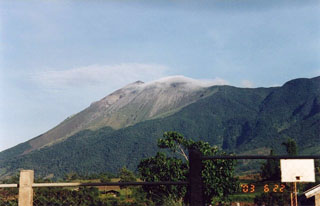Report on Kanlaon (Philippines) — 8 January-14 January 2025
Smithsonian Institution / US Geological Survey
Weekly Volcanic Activity Report, 8 January-14 January 2025
Managing Editor: Sally Sennert.
Please cite this report as:
Global Volcanism Program, 2025. Report on Kanlaon (Philippines) (Sennert, S, ed.). Weekly Volcanic Activity Report, 8 January-14 January 2025. Smithsonian Institution and US Geological Survey.
Kanlaon
Philippines
10.4096°N, 123.13°E; summit elev. 2422 m
All times are local (unless otherwise noted)
The Philippine Institute of Volcanology and Seismology (PHIVOLCS) reported continuing eruptive activity at Kanlaon during 7-13 January. The seismic network recorded 11-22 daily volcanic earthquakes that, during 7-8 and 11-13 January, included 1-7 periods of volcanic tremor lasting 10 minutes to one hour and 57 minutes. Average daily sulfur dioxide emissions ranged from 2,029 to 5,763 tonnes per day, with the upper limit being close to the average recorded since the 3 June 2024 eruption. Daily gas emissions that occasionally contained ash were often voluminous, rising as high as 1 km above the summit and drifting in multiple directions. There were 1-3 daily periods of ash emissions during 7-8 and 12-13 January, each as short as five minutes to as long as one hour and 55 minutes. The ash plumes mainly drifted W, WSW, and SW. Rapid inflation of the mid-to-upper part of the E flank was detected at 1920 on 10 January in tilt data recorded by the Upper Pantao Observation station (VKUP) located at 1,056 m elevation on the E flank.
The eruption continued to impact residents. The National Disaster Risk Reduction and Management Council (NDRRMC) report issued at 0800 on 12 January stated that 10,003 people (3,158 families) were spread across 25 evacuation centers and another 7,576 people (2,409 families) were staying elsewhere. The Alert Level remained at 3 (on a scale of 0-5); the public was warned to stay 6 km away from the summit and pilots were warned not to fly close to the volcano.
Geological Summary. Kanlaon volcano (also spelled Canlaon) forms the highest point on the Philippine island of Negros. The massive andesitic stratovolcano is covered with fissure-controlled pyroclastic cones and craters, many of which are filled by lakes. The largest debris avalanche known in the Philippines traveled 33 km SW from Kanlaon. The summit contains a 2-km-wide, elongated northern caldera with a crater lake and a smaller but higher active vent, Lugud crater, to the south. Eruptions recorded since 1866 have typically consisted of phreatic explosions of small-to-moderate size that produce minor local ashfall.
Sources: Philippine Institute of Volcanology and Seismology (PHIVOLCS), The National Disaster Risk Reduction and Management Council (NDRRMC)

